North American Wind Energy Academy 2023 Recap
From Spooky to Scholarly: Highlights From the 2023 NAWEA/WindTech Conference
This past Halloween, wind energy researchers, educators, students, and industry members, as well as government and nonprofit representatives from around the world, gathered in a hotel ballroom in Broomfield, Colorado, for a critical purpose: an impromptu costume contest.
It was the All Hallows’ Eve Banquet, capping off day two of the North American Wind Energy Academy (NAWEA)/WindTech 2023 Conference. Given the occasion, costumes were encouraged. However, the costumes were so good, conference-goers wanted to stage a friendly competition. A Viking, a banana, a Maleficent, and others presented their ensembles to the crowd, who rated each costume via the volume of its applause. In the end, Gordon Stewart, a former NREL intern who now teaches engineering at Rhode Island’s Roger Williams University, claimed first place by dressing as a floating offshore wind turbine.
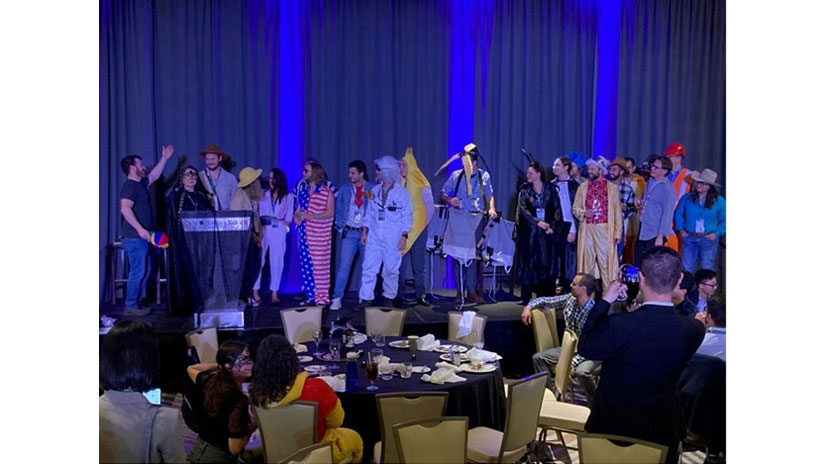
The costumes at the NAWEA/WindTech 2023 Conference’s All Hallows’ Eve Banquet were so good, attendees decided to stage an impromptu costume contest. Photo by Paul Veers, NREL
“I’ve always loved Halloween, and I always do big costumes,” Stewart said. “In my opinion, if your costume can fit through a door, then you haven’t done Halloween correctly. Given the theme of the conference and the research I was presenting, I figured a floating offshore wind turbine was fitting.”
However, this time, Stewart had to fly across the country for Halloween, which presented some challenges. Ever the engineer, Stewart took this as an opportunity to be creative and resourceful.
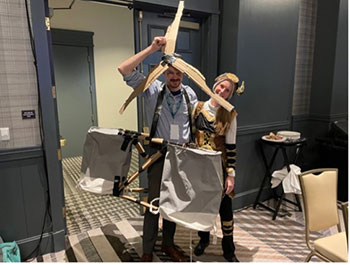
Roger Williams University engineering professor and former NREL intern Gordon Stewart won the NAWEA/WindTech 2023 Conference’s impromptu costume contest with his floating offshore wind turbine. He is pictured here with Technical University of Denmark researcher Katherine Dykes, who dressed as a Viking. Photo by Matt Lackner, NREL
“My main design criteria were that I had to be able to fly with it,” Stewart said. “I packed a roll of duct tape as well as three collapsible laundry hampers to use as the turbine pontoons. Then when I got to my hotel, I asked for some old cardboard boxes, which I cut up into turbine blades and the truss structure between my laundry hamper pontoons. I held the whole thing together with the duct tape, which I also used to secure the turbine blade to my head.”
The costume contest—and Stewart’s victory—were just a few highlights from the conference, which was held Oct. 30–Nov. 1, 2023, with supplemental events Nov. 2–3. Over those five days, the conference offered plenary sessions, workshops, and poster presentations focused on a range of wind energy issues, like atmospheric science, turbine aeroelasticity, and the intersection of technology with social and environmental issues.
The premier scientific and interdisciplinary conference on wind energy in North America, the NAWEA/WindTech Conference began 10 years ago as two separate events: the NAWEA Symposium and the WindTech Conference. The two events joined forces in 2019 to become the annual NAWEA/WindTech Conference, which aims to bring together members of the wind energy community to present their research, share their ideas, and create opportunities for collaboration.
The 2023 conference foregrounded key challenges in today’s wind energy landscape. Throughout the conference, attendees called attention to the need for:
- Dialogue across the many different energy sectors and areas of expertise as wind energy integrates further into the nation’s power mix
- Credible, high-quality information about wind energy and its role in international, national, and local development
- Wind energy evaluation that looks beyond cost and recognizes wind energy’s broader value and impacts relative to all other energy sources
- Realistic wind energy deployment projections that consider the current difficulty with developing wind energy projects, specifically around environmental and social impacts
- Support for wind energy research and development that aligns with the levels of wind energy deployment needed to reach global clean-energy goals.
Keep reading for more highlights from the 2023 conference.
Congressman Joe Neguse Delivers Keynote Speech
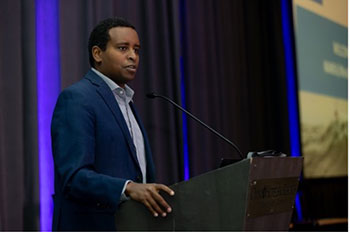
Colorado Congressman Joe Neguse delivered a keynote speech in which he highlighted the importance of addressing opposing viewpoints with respect and understanding. Photo by Joe DelNero, NREL
Congressman Joe Neguse, who represents Colorado’s 2nd District, kicked off the conference with a keynote speech. In his remarks, Congressman Neguse emphasized the importance of approaching skepticism about wind and renewable energy with respect and understanding.
“Congressman Neguse was asked, ‘How do we communicate with people who are resistant to clean energy technology?’” recalled NREL researcher and NAWEA Executive Director Paul Veers. “He responded by saying that it’s about listening first, rather than jumping in and trying to explain things before you really know where someone is coming from. I think a lot of people appreciated that perspective.”
Awards Ceremony Honors Wind Energy Pioneers
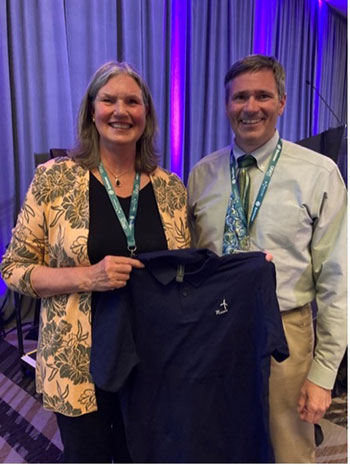
Retired NREL researcher Sue Hock, pictured here with Northern Arizona University mechanical engineering professor and NAWEA board member Tom Acker, received the Wind Energy Pioneer Award in recognition of her 30-year career in wind and renewable energy research. Photo by Paul Veers, NREL
At the conference banquet, retired NREL researcher Sue Hock and NREL emeritus researcher Bob Thresher each received a Wind Energy Pioneer Award for their critical contributions in the early days of wind energy research in North America. Hock worked at NREL for more than 30 years in a career that spanned solar energy, economic analysis, wind energy, and hydrogen research. Thresher, who was unable to attend, was principal researcher in the development of early wind energy technologies as well as an architect of the wind energy program at NREL and the creation of the National Wind Technology Center at NREL’s Flatirons Campus. Hock accepted Thresher’s award on his behalf.
“Bob and Sue were an inseparable team, often referred to as ‘Bob-Sue,’ in constructing the DOE wind energy research community. They worked across labs, with industry and universities, to solve some of the most challenging problems of wind technology development,” Veers said. “In those days, Sue was often the only woman in the room and served as an effective role model for the many female researchers who followed her.”
Plenary Sessions Invite Cross-Disciplinary Perspectives
Each day, conference-goers could attend a plenary session focused on the near-, mid-, or long-term challenges facing the wind energy industry.
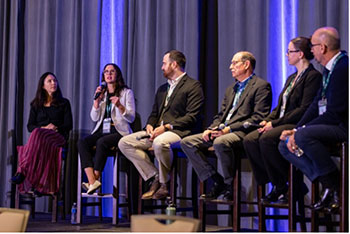
Experts from various wind energy topics, including, from left to right, Suzanne Tegan, Bethany Straw, Chris Bay, Paul Veers, Julie Lundquist, and Carlo Botasso, discussed the long-term challenges of wind energy at Wednesday’s plenary session. Photo from Justin LeVett Photography
“Often , if a conference has a plenary, they'll have a group of speakers on a specific topic and do a bit of a deep dive into that topic, which can be very educational,” Veers explained. “We took a slightly different approach and put experts from different topics in wind energy—for example, an expert on turbine design, an expert on grid reliability, and an expert on the environmental impacts of wind energy—on the panel at the same time and let them discuss what, for example, the long-term challenges of wind energy might mean for their area. It was kind of an experiment, and I think it was well received.”
NREL Day Keeps the Party Going
The conference concluded on Wednesday, Nov. 1, but there were still two more days of wind-energy-focused activities in store.
“We had just held the conference, so we decided to take advantage of the fact that so many folks from the wind energy community would be in town,” Veers said. “We held two days of NREL-led supplemental events beginning on Thursday, which we unofficially called ‘NREL Day.’”
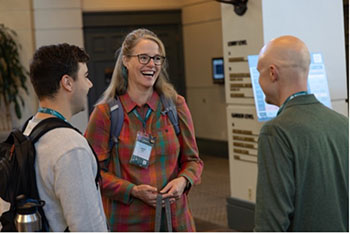
The conference offered meetings, workshops, and opportunities for conference-goers to network and learn from each other. Photo by Joe DelNero, NREL
NREL Day consisted of workshops in which attendees learned to use new wind-energy modeling and analysis software, meetings in which attendees learned to use NREL research tools, and a university summit, run by NREL researcher Ian Baring-Gould, to look at interactions between the U.S. Department of Energy’s (DOE's) Wind Energy Technologies Office and university programs focused on wind energy. Various International Energy Agency (IEA) Wind task groups also met, maximizing the value of so many international participants being in the same place.
“We had a great turnout for NREL Day,” Veers said. “By holding all those extra activities in one day, we made it possible for people who otherwise might not have been able to be there in person to participate.”
Symposium Invites Grad Students To Hone Their Skills
Finally, that Friday, NAWEA sponsored a graduate student symposium. Organized by NREL researchers Stefano Letizia, Michael Kuhn, and Brooke Stanislawski, the symposium offered graduate students—whether they attended the conference or not—an opportunity to practice their presentation and interview skills while connecting with others in their field of study.
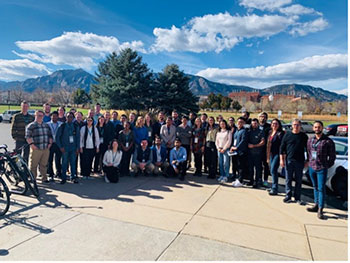
NREL researchers Michael Kuhn (far left, back row), Stefano Letizia (far right), and Brooke Stanislawski (not pictured) organized a NAWEA-sponsored graduate student symposium. Photo by Stefano Letizia, NREL
“We decided to hold the symposium that Friday because we wanted the grad students to be able to take advantage of all the other events and educational opportunities happening throughout the week,” Veers explained. “By setting aside a dedicated day for the symposium, we hoped to create a more protected, less stressful environment where grad students could get to know each other and develop those key skills that will help them become the next generation of leaders in wind and renewable energy.”
The NAWEA/WindTech 2023 Conference was hosted by NREL in partnership with the University of Colorado Boulder Renewable and Sustainable Energy Institute, the Colorado State University Center for the New Energy Economy, Colorado School of Mines, the National Oceanic and Atmospheric Administration, the National Center for Atmospheric Research, and the University of Wyoming. NAWEA sponsors the NAWEA/WindTech Conference every year. The 2024 conference will be hosted by Rutgers University in New Brunswick, New Jersey.
Last Updated May 28, 2025
